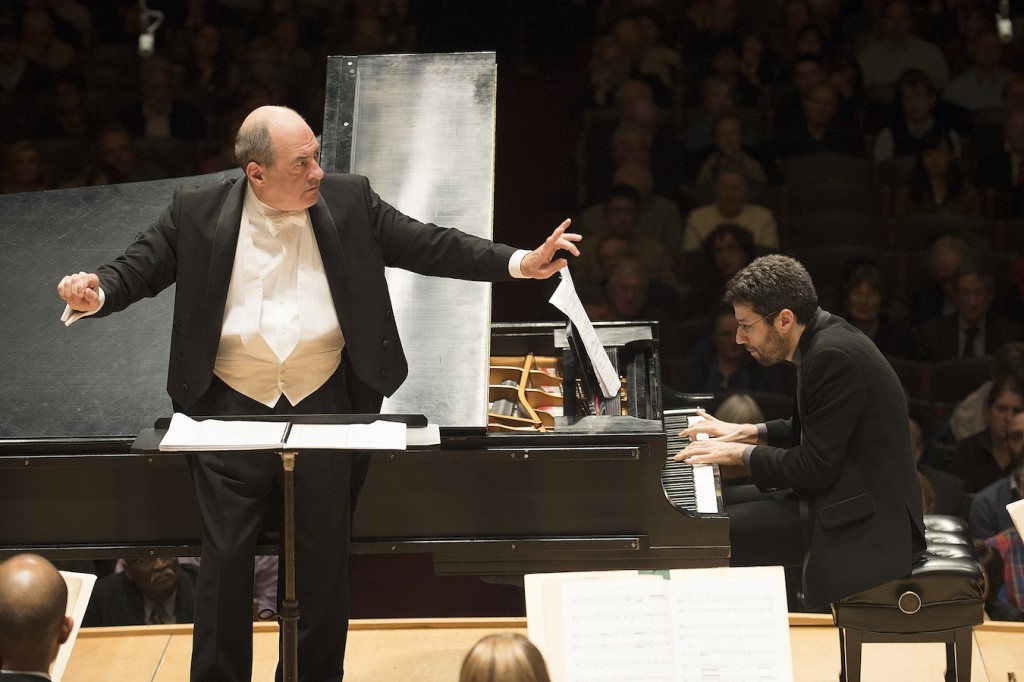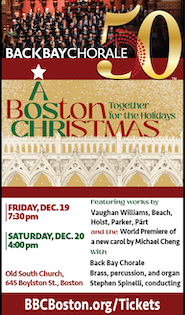Bernard Rands’ witty concerto charms in BSO’s world premiere

Robert Spano led the Boston Symphony Orchestra with soloist Jonathan Biss in the world premiere of Bernard Rands’ “Concerto for Piano and Orchestra.” Photo: Stu Rosner
Composer Bernard Rands does not want you to confuse his new piece for piano and orchestra with a piano concerto. Piano concertos are big and loud and last the better part of an hour.
Emphasizing wit and tenderness over virtuoso heroics, Rands’s score kept Biss busy in the middle part of the keyboard, throwing a dry staccato chord here, a little spray of notes there, while the orchestra behind him rumbled, shimmered, and explored seemingly every timbre in between. One might go Rands one better and call it a “concerto for orchestra and piano.”
But Biss made the most of his scaled-down soloist’s role, putting sharp points on the notes during the lively parts and softening into finely voiced chords when the music turned dreamy. The British-born, Chicago-based composer’s music sounded distinctly American in these Yanks’ hands, with Spano’s clear, wide-open sonorities complementing Biss’s Gershwin-like bright tone and sassy syncopations.
The concerto’s three concise movements began with a striking effect, long notes in the strings with delayed doubling by winds creating a sort of cathedral resonance around the string sound. At the opposite end of the sonic spectrum, Rands dotted the piece everywhere with extremely short, barely-there staccato notes and chords.
The first movement laid out its atonal harmonic and melodic argument quite clearly, with the orchestra and piano standing somewhat apart and commenting on each other until near the end, when they got together for an exciting crescendo and a bang-bang finish.
For adjectives and punctuation to describe the second movement, this review can’t improve on the tempo marking in the score: “Slow, quiet, vague and mysterious!” Pianissimo high strings and celesta created a celestial atmosphere indeed, with brief flares of sensuality from woodwinds or muted brass. The music’s cloudy ambiance sounded more like “Nuages” than Debussy’s piece itself did when performed earlier in this program. In his quiet musings, Biss caressed the keys, giving his blues-tinged melodies a Chopinesque glow.
The fanciful finale was even more of a riot of orchestral color, led in turn by harps, flutes, brass, and a McGee’s closet of percussion (glockenspiel, gong, tubular bells, bass drum, two triangles, etc., etc.). It came as a relief when Rands gave the pianist a traditional solo cadenza; allowed to shine on his own for once, Biss offered a witty and expressive take on the concerto’s musical ideas.
This modest concerto closed with a few more of those short staccato chords, pianissimo, like snowflakes hitting your face. It seemed to charm the audience—at least those who weren’t bothered by atonal harmony and the lack of conventional piano pyrotechnics—and there was warm applause for the pianist and conductor, and also the 80-year-old composer, who bounded onstage to share in the bows.
As mentioned, the program opened with Debussy’s “Nuages” and “Fêtes,” the two movements of Nocturnes that don’t require a chorus. The music sounded a little truncated that way, as the brilliant “Fêtes” disintegrates at the end, and seems to need the last movement “Sirènes” to pull things back together. But the two pieces served well enough as appetizers for the colorful modern music to follow.
Spano conducted both pieces with a marked, steady beat, as if he wasn’t about to let Debussy go all swoony on him. “Nuages” (Clouds), described by the composer as “like the study of gray in painting,” began more like an etching, with the slithering winds coming in a good deal brighter and louder than the indicated pianissimo diminuendo. Spano and the players did achieve some fine, delicate pianissimos later in the piece.
“Fêtes” (Festivals),with its distant trumpet calls and bustling foreground, was executed with admirable energy and attention to balances, but a little short on festive spirit, at least until a long, inexorable crescendo from nothing to crashing fortissimo lifted listeners out of their seats.
If any of those listeners thought a bit of Rachmaninoff after the interval would provide relief from modernism, they were in for a surprise, as Spano not only embraced this composer’s acerbic late style in the Symphonic Dances, he emphasized it by slowing the tempos, laying down a thumping beat, and generally seeming to emulate The Rite of Spring and Prokofiev rather than this composer’s lush earlier concertos.
Fortunately, this music could take it. Whether writing for solo piano or for orchestra, Rachmaninoff used a lot of notes, and it was worth taking the time to appreciate his workmanship. And Spano made a case for savoring the score’s dissonances, making them hurt a little, instead of smoothing them over with a fleet-footed dance beat.
At the outset, the orchestra seemed to have trouble adjusting to Spano’s slow tempo, playing raggedly for the first couple of pages before arighting itself. But whatever the music lost in forward momentum it gained in suspense during the long crescendos, and Spano broadened even more at the climaxes, to great effect.
In the first movement’s long episode for alto saxophone with only woodwinds in accompaniment, Adam Pelandini rendered the aching solo melody expressively, with a big, round, mellow tone that was somewhat masked by the harder-edged sound of oboes and clarinets.
Contributing to the overall impression of “thoughts of a dry brain in a dry season” was the BSO’s signature string sound, lean and elegant—and a world away from the voluptuous Philadelphia Orchestra strings for which Rachmaninoff composed the piece. Perhaps inevitably, the score’s big moments for soaring or plunging strings sounded a bit reserved on Thursday night. (Maybe that helps explain why, according to the program’s performance notes, the BSO didn’t take up this piece until nearly 35 years after its premiere.)
Emphasizing everything bright and sarcastic about the second movement, Spano gave the hesitant waltz a satirical feel Shostakovich would have recognized. Once again, the conductor built a long crescendo at mid-movement, energizing the music and saving it from moroseness.
The finale was enlivened by incisive attack in the up-tempo sections, expressive (if not lush) string playing in the interlude, and a big buildup of Rachmaninoffian rat-a-tat leading to an all-out, walloping ensemble finish. The applause, however, seemed more appreciative than enthusiastic, and most patrons stayed in their seats (not the usual practice in these days of routine standing ovations). Perhaps they were missing their old Romantic friend.
The program will be repeated 1:30 p.m. Friday and 8 p.m. Saturday and Tuesday. bso.org; 617-266-1200.
Posted in Performances
